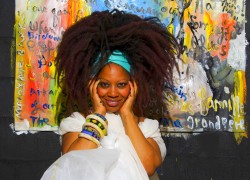
Words by Fabrice Wilmann
Racial divisions remain at the forefront of the American cultural landscape – a thread embedded in American history that has continued to unravel in the present, with no discernible end in sight. We only need to look as far as the Black Lives Matter movement to see that racial tensions continue to tear at the social fabric of the nation: a thread that one Melbourne Fringe artist will explore this year.
A native of the United States who now considers herself a global citizen, Maxime Banks explores the social inequity faced by African Americans through black portraiture. She reflects upon the cuts and derisions inflicted upon the ‘black body’ and envisions an alternate, futuristic reality where racial inequality no longer exists.
“My show is called Black to the Future, reimagining the past of African-Americans. I’m dealing with police brutality and violence… and I’m inspired by science-fiction to reimagine a different narrative,” says Maxime.
The artist believes her show will translate to Australian audiences due to the similar cultural landscape. “Part of my history includes the social injustice of the incarceration of black men and women. And here in Australia that is also happening, so I’m not just concerned with Americans but also with Indigenous black people.”
“My black brothers and sisters also suffer, and that was something I wasn’t aware of before I came to Australia. But I’ve been here a while now and I’ve seen the injustice upon the black body.”
Banks cites one of her primary artistic inspirations as afrofuturism, which critiques the current social injustices faced by people of colour as well as re-examining and questioning the past. Banks considers elements from science-fiction, fantasy, history and magic realism when visualising and shaping her performance.
“The site of my show [the Meat Market] is a massive, very theatrical space. So I was thinking okay, I’m going to make my show more theatrical, an immersive experience like outer space and to use some blue UV lights so when people walk into the show, it’s like walking into an outer space with stars and floating portraits. I’m gonna try and think of a way that maybe I can incorporate [my poems and spoken word performances] and maybe I can use projections as a way of combining my different writings.”
Discussing Banks’ performance, it became evident that the idea for Black to the Future was still taking shape in her mind, yet to reach its end point. This is the very essence of her work: the lines between the past, the present and the future are blurred, and the boundless potential for re-imagined, future realities will give shape to a performance that will hope to challenge the viewer’s preconceptions of the ‘black experience.’
The focal point of Maxime’s work is, without a doubt, her passion for social justice. Discussing the Black Lives Matter movement and increasing reports of police brutality against African Americans, it wasn’t difficult to sense her emotional connection.
“I’ve been following it all, and it’s just become a continuing reverberation in my work,” she says. Though emotional, the artist never sounds resigned.
So, the inevitable question rears its head: does Maxime see her performance, her imagined reality, as a possible realistic future? Her answer is a resounding, unequivocal: “Yes.”
Photo: Claudia Phares

